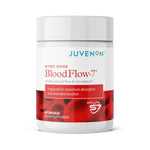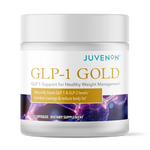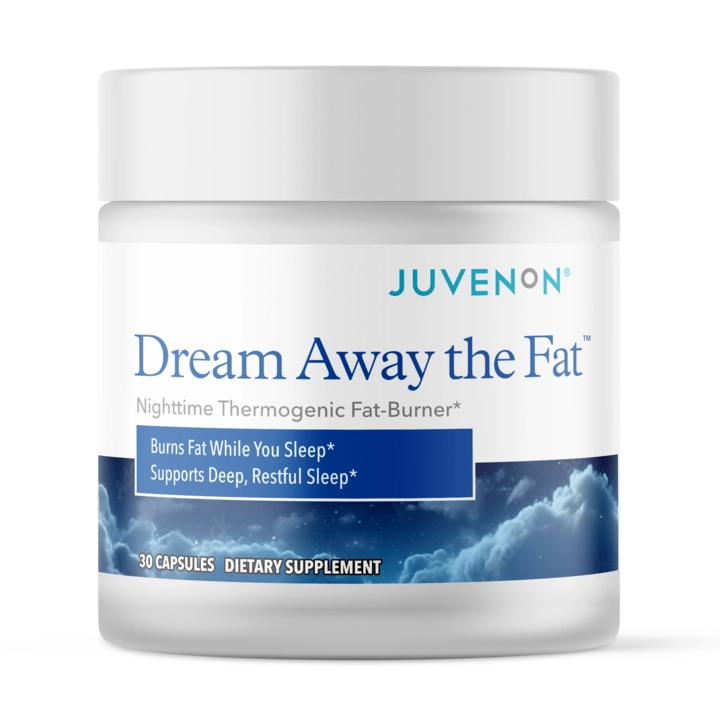
If you have cold hands and feet, then you already know how annoying it can be to deal with. Always carrying a sweater in case you get cold (even in the summer), always stuffing your hands in your pockets trying to get warm, and sleeping in heavy socks are the norm.
But did you know that in some cases, cold hands and feet can be a sign of poor circulation?
Fortunately, there are several ways that you can improve your circulation, regardless of your age.
In this article, we’ll review:
- What causes cold hands and feet,
- How you may be able to improve your blood flow naturally by attaining a healthy weight, exercising regularly, quitting smoking, reducing stress, and getting enough sleep,
- The role of nitric oxide in blood flow,
- And how Juvenon’s BloodFlow-7 supplement can help get your blood pumping to warm up your fingers and toes.
Why are my hands and feet always cold?
Both of these problems are related to poor circulation. Cold hypersensitivity in the hands and feet is more common in women, people of Asian descent, and people with a low body mass index (BMI). Researchers have also found that there’s a strong genetic component to cold hypersensitivity in the hands and feet.[2]
Most researchers and medical professionals agree that cold hypersensitivity in the hands and feet is caused bycontracted, or restricted, blood vessels in the hands and feet. This contraction can be due to a variety of reasons, including stress or medical issues.[1]
Cold hands and feet are a really common problem — so common, in fact, the condition even has an official name:cold hypersensitivity in the hands and feet. A similar condition, calledRaynaud’s phenomenon, is characterized by extremities that change color (to white, blue, or red) when exposed to cold weather.[1]
Importance of nitric oxide
Nitric oxide is a gas that is produced by your body. It plays an important role in blood vessel regulation by acting on the epithelium of your blood vessels.
The epithelium is the inner lining of a blood vessel. It is extremely flexible and can contract (tighten) or dilate (open) in response to signals it receives from the body. When the epithelium contracts the blood vessels, your blood pressure rises, your heart rate increases, and your blood flow suffers. It becomes more difficult for blood to travel through the restricted vessels. [3]
On the other hand, when the epithelium dilates, your blood pressure and heart rate both decrease, and your blood flow improves because the blood is able to travel unimpeded through the wider vessels. [3]
Nitric oxide signals for the blood vessels to dilate or widen. However, there are several ways that your body’s nitric oxide activity can be suppressed. Many strategies to help improve blood flow actually focus on improving nitric oxide activity and your body’s responsiveness to nitric oxide. [3]
How to improve blood flow

To naturally help improve your blood flow, there are a plenty of changes you can make. Here are a few:
- Attain a healthy weight. If you’re overweight, the excess weight may be limiting your blood flow. However, you may also struggle with cold hands and feet if you’re underweight. Whether you need to lose or gain some weight to enter a healthy BMI range, this may help improve your blood flow and overall health.
- Quit smoking. Smoking can limit your lung function, which will affect the oxygenation of your blood and could impede your blood flow. Researchers have even found that smoking interferes with nitric oxide production, meaning it could directly restrict your blood flow in this way. [4]
- Exercise regularly. Exercise is a great way to improve your circulation and overall health. Aim for at least 150 minutes per week of moderate-intensity exercise to see the most benefit. Exercise and nitric oxide have a synergistic relationship. Exercise boosts nitric oxide production, while in turn nitric oxide can increase blood flow and help improve exercise performance. [5]
- Reduce stress. Stress can cause your blood vessels to constrict. Think about how your body reacts when you get stressed — your blood pressure may increase and your heart beats faster. These are due to blood vessel constriction. Find ways to reduce your stress levels to promote relaxation, blood flow, and overall wellness.
- Get enough sleep. A well-rested body can handle stress much better than a sleep-deprived one, and that lower stress level may result in better blood flow. Research shows that sleep deprivation is linked to free radical damage, and free radical damage may impair nitric oxide utilization. Most adults, regardless of age, need at least 7 hours per night. [6]
These lifestyle changes may not only help with blood flow, but they are also important for optimizing your overall health.
Boost nitric oxide with BloodFlow-7
Additionally, it may be worthwhile to add a nitric oxide boosting supplement to your daily routine. Nitric oxide boosters are often made with natural ingredients that can help improve your blood flow by acting on nitric oxide.
BloodFlow-7, from Juvenon, is one such nitric oxide booster. It is made with a combination of powerful natural ingredients that have been scientifically shown to support improved blood flow. BloodFlow-7 works in three distinct ways to boost nitric oxide production and utilization:
- It helps to increase nitric oxide production
- It helps to improve nitric oxide utilization, or how efficiently the body uses it
- It helps protect nitric oxide from being destroyed by free radicals
Here’s a little bit more about the ingredients in BloodFlow-7.
Nitric Oxide Precursor Blend
Your body uses amino acids, or building blocks of protein, to synthesize nitric oxide. These amino acid nitric oxide precursors include citrulline and arginine — both of which are found in BloodFlow-7.
Citrulline and arginine may help to increase nitric oxide production in the body. [7, 8]
Additionally, the Nitric Oxide Precursor Blend in BloodFlow-7 also contains glutathione. Glutathione is a powerful antioxidant that can help to protect nitric oxide from free radical damage, which can degrade it. [9]
In these ways, the Nitric Oxide Precursor Blend helps to directly increase nitric oxide production via citrulline and arginine and protect it from being degraded by free radicals thanks to the glutathione.
Beet root extract
BloodFlow-7 also contains beet root extract, which is a natural source of nitrites. As you may be able to tell from the similarities in the names, nitrites can be broken down into nitric oxide.
Nitrites are converted into nitric oxide via a different metabolic pathway than citrulline and arginine, so BloodFlow-7 can boost nitric oxide production in two distinct ways.
Researchers have found that beet root extract is a safe and natural way to effectively increase nitric oxide production, improve endothelial flexibility, and decrease blood pressure. [10]
S7 Blend
BloodFlow-7 also features a blend of seven natural, plant-based ingredients that are rich in antioxidants. These ingredients help to preserve the nitric oxide your body produces, so that it’s not destroyed from free radical damage. This allows the nitric oxide to have a longer effect, so that you can feel the benefits for a more extended period of time.
The S7 Blend consists of:
BloodFlow-7 also features a blend of seven natural, plant-based ingredients that are rich in antioxidants. These ingredients help to preserve the nitric oxide your body produces, so that it’s not destroyed from free radical damage. This allows the nitric oxide to have a longer effect, so that you can feel the benefits for a more extended period of time.
The S7 Blend consists of:
- Green coffee bean extract:Green coffee bean extract is loaded with antioxidants, such as chlorogenic acid, that may help boost nitric oxide function. [11]
- Green tea leaf extract: Green tea contains antioxidant compounds that can help to neutralize free radicals. [12]
- Turmeric root extract:Turmeric contains curcumin, a potent antioxidant that — like green coffee and green tea — may help protect against free radicals. [13, 14]
- Tart cherry:Tart cherry has been shown to help improve blood flow, and is often used for heart health and exercise recovery. It has antioxidant effects too. [15]
- Blueberry:In addition to antioxidants, blueberries may help to improve endothelial function. [16]
- Broccoli:Broccoli is rich in free radical fighting compounds, such as sulforaphane and quercetin. [17, 18]
- Kale:Like broccoli, kale contains some free radical fighting antioxidants. [19]
Trans-resveratrol
Finally, BloodFlow-7 contains the antioxidant trans-resveratrol. This is the same antioxidant found in foods like chocolate and red wine. As an antioxidant, it can protect nitric oxide from being degraded by free radicals, but it can actually stimulate further nitric oxide production, too. [20]
Takeaway
If your hands and feet are constantly cold, know that you’re not alone. It’s a surprisingly common problem. This cold hypersensitivity in the hands and feet is more common in women, Asian people, and people with a low BMI.
Generally, cold hands and feet are related to poor blood flow in these extremities — which can be related to stress or medical problems.
However, there are several natural ways to help improve blood flow — such as exercise, moving towards a healthy weight, quitting smoking, reducing stress, and getting enough sleep.
Many of these changes may actually help your body create more nitric oxide or respond to nitric oxide more effectively. Nitric oxide is a gas that helps to dilate your blood vessels. This causes them to widen, improving blood flow and decreasing blood pressure.
In addition, Juvenon’s BloodFlow-7 should be a daily part of your routine if you are sick of being cold all the time. This supplement is designed to improve blood flow in three different ways: increasing nitric oxide production, improving how well the body uses nitric oxide, and protecting nitric oxide from being broken down by free radicals.
It works through a unique blend of natural ingredients — including amino acids, antioxidants, and fruits and vegetables.
If you’re ready to warm up, don’t hesitate to implement some of these healthy lifestyle changes and try BloodFlow-7.
Sources
1. Bae KH, Jeong YS, Go HY, et al. The definition and diagnosis of cold hypersensitivity in the hands and feet: Finding from the experts survey. Integr Med Res. 2018;7(1):61-67. doi:10.1016/j.imr.2017.11.001
2. Hur YM, Chae JH, Chung KW, et al. Feeling of cold hands and feet is a highly heritable phenotype. Twin Res Hum Genet. 2012;15(2):166-169. doi:10.1375/twin.15.2.166
3. Chen K, Pittman RN, Popel AS. Nitric oxide in the vasculature: where does it come from and where does it go? A quantitative perspective. Antioxid Redox Signal. 2008;10(7):1185-1198. doi:10.1089/ars.2007.1959
4. Toda N, Okamura T. Cigarette smoking impairs nitric oxide-mediated cerebral blood flow increase: Implications for Alzheimer's disease. J Pharmacol Sci. 2016;131(4):223-232. doi:10.1016/j.jphs.2016.07.001
5. Oral O. Nitric oxide and its role in exercise physiology. J Sports Med Phys Fitness. 2021;61(9):1208-1211. doi:10.23736/S0022-4707.21.11640-8
6. Villafuerte G, Miguel-Puga A, Rodríguez EM, Machado S, Manjarrez E, Arias-Carrión O. Sleep deprivation and oxidative stress in animal models: a systematic review. Oxid Med Cell Longev. 2015;2015:234952. doi:10.1155/2015/234952
7. Ströhle A, von Bibra H, Hahn A. Bedeutung von L-Arginin für die Gefäßgesundheit [L-Arginine and vascular health]. Med Monatsschr Pharm. 2016;39(12):515-520.
8. Figueroa A, Wong A, Jaime SJ, Gonzales JU. Influence of L-citrulline and watermelon supplementation on vascular function and exercise performance. Curr Opin Clin Nutr Metab Care. 2017;20(1):92-98. doi:10.1097/MCO.0000000000000340
9. Robaczewska J, Kedziora-Kornatowska K, Kozakiewicz M, et al. Role of glutathione metabolism and glutathione-related antioxidant defense systems in hypertension. J Physiol Pharmacol. 2016;67(3):331-337.
10. Kapil V, Khambata RS, Robertson A, Caulfield MJ, Ahluwalia A. Dietary nitrate provides sustained blood pressure lowering in hypertensive patients: a randomized, phase 2, double-blind, placebo-controlled study. Hypertension. 2015;65(2):320-327. doi:10.1161/HYPERTENSIONAHA.114.04675
11. Ochiai R, Jokura H, Suzuki A, et al. Green coffee bean extract improves human vasoreactivity. Hypertens Res. 2004;27(10):731-737. doi:10.1291/hypres.27.731
12. Agnetti G, Bordoni A, Angeloni C, et al. Green tea modulation of inducible nitric oxide synthase in hypoxic/reoxygenated cardiomyocytes. Biochimie. 2005;87(5):457-460. doi:10.1016/j.biochi.2005.01.004
13. Sun J, Chen F, Braun C, et al. Role of curcumin in the management of pathological pain. Phytomedicine. 2018;48:129-140. doi:10.1016/j.phymed.2018.04.045
14. Lin X, Bai D, Wei Z, et al. Curcumin attenuates oxidative stress in RAW264.7 cells by increasing the activity of antioxidant enzymes and activating the Nrf2-Keap1 pathway. PLoS One. 2019;14(5):e0216711. Published 2019 May 21.
doi:10.1371/journal.pone.0216711
15. Keane KM, Haskell-Ramsay CF, Veasey RC, Howatson G. Montmorency Tart cherries (Prunus cerasus L.) modulate vascular function acutely, in the absence of improvement in cognitive performance. Br J Nutr. 2016;116(11):1935-1944.
doi:10.1017/S0007114516004177
16. Bharat D, Cavalcanti RRM, Petersen C, et al. Blueberry Metabolites Attenuate
Lipotoxicity-Induced Endothelial Dysfunction. Mol Nutr Food Res.
2018;62(2):10.1002/mnfr.201700601. doi:10.1002/mnfr.201700601
17. Anand David AV, Arulmoli R, Parasuraman S. Overviews of Biological Importance of Quercetin: A Bioactive Flavonoid. Pharmacogn Rev. 2016;10(20):84-89. doi:10.4103/0973-7847.194044
18. Greaney AJ, Maier NK, Leppla SH, Moayeri M. Sulforaphane inhibits multiple
inflammasomes through an Nrf2-independent mechanism. J Leukoc Biol.
2016;99(1):189-199. doi:10.1189/jlb.3A0415-155RR
19. Šamec D, Urlić B, Salopek-Sondi B. Kale (Brassica oleracea var. acephala) as a superfood: Review of the scientific evidence behind the statement. Crit Rev Food Sci Nutr. 2019;59(15):2411-2422. doi:10.1080/10408398.2018.1454400
20. Xia N, Förstermann U, Li H. Resveratrol and endothelial nitric oxide. Molecules. 2014;19(10):16102-16121. Published 2014 Oct 9. doi:10.3390/molecules191016102






















